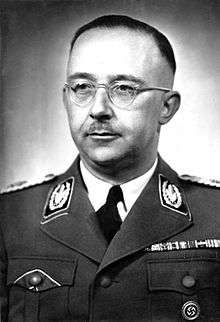Personal Staff Reichsführer-SS
| Hauptamt Persönlicher Stab Reichsführer-SS | |
|
Command flag for Reichsführer-SS 1935–1945. | |
|
The Hauptamt Persönlicher Stab Reichsführer was a main office of the SS. | |
.jpg) Reichsführer-SS Heinrich Himmler with his adjutant, SS-Oberführer Karl Wolff in 1933. | |
| Agency overview | |
|---|---|
| Formed | c.1933 |
| Dissolved | May 8, 1945 |
| Jurisdiction |
Occupied Europe |
| Headquarters |
Prinz-Albrecht-Straße, Berlin 52°30′26″N 13°22′57″E / 52.50722°N 13.38250°E |
| Employees | ~ 120 (c.1944)[1] |
| Minister responsible |
|
| Agency executives |
|
| Parent agency |
|
The Personal Staff of the Reich Leader of the SS (German: Hauptamt Persönlicher Stab Reichsführer-SS) was a main office of the SS which was established in 1933 by Heinrich Himmler to serve as a personal office coordinating various activities and projects subordinate to the Reichsführer-SS.
Operations
In 1933, Karl Wolff came to the attention of Himmler who in June 1933, appointed Wolff his adjutant and made him chief of the office of his Personal Staff.[2] Himmler also appointed Wolff the SS Liaison Officer to Hitler.[3] Wolff would eventually become an SS-Obergruppenführer und General der Waffen-SS.[4] As Himmler's principle adjutant and close associate, Wolff's daily activities involved overseeing Himmler's schedule and serving as a liaison with other SS offices and agencies. The office conveyed the wishes/interests of the Reichsführer to all branches, offices, and subordinated units within the SS. It also handled Himmler's personal correspondence and awarded decorations. Wolff managed Himmler's affairs with the Nazi Party, state agencies and personnel.[5] Following the assassination of Reinhard Heydrich in 1942, Wolff fell out with Himmler and was replaced by SS-Obergruppenführer Maximilian von Herff who served as its head until the end of the war.
Additional roles
Himmler also established several special project teams under the authority of his personal office. This included the staff of the Wewelsburg castle as well as the Ahnenerbe. This team of experts was interested in the anthropological and cultural history of the Aryan race. It conducted experiments and launched voyages with the intent of proving that prehistoric and mythological Nordic populations had once ruled the world.
Role in the Holocaust
The exact role that Himmler's personal staff played in the Holocaust has been a subject of great debate with Karl Wolff attesting that the personal staff were little more than desk bound paper pushers who had little to nothing to do with the atrocities committed by the SS.[6] However, given that most of Himmler's wishes and orders were distributed by his personal staff, it remains highly doubtful that Wolff and his office were unaware of what was occurring.
For example, as the liquidation of the Warsaw ghetto resulted in rail transport bottlenecks, Wolff telephoned deputy Reich Minister of Transport Dr. Albert Ganzenmüller. In a later letter dated 13 August 1942, Wolff thanked Ganzenmüller for his assistance.
"I notice with particular pleasure your report that for 14 days a train has been going daily with members of the chosen people to Treblinka. I've made contact with the participating agencies, so that a smooth implementation of the entire action is ensured."
Further, Wolff would have received copies of all letters from SS officers, and his friends at that point included the organizer of "Operation Reinhard" Odilo Globocnik. Therefore, his later denial of knowledge of Holocaust activities may be plausible only at the detailed level of atrocities by the Nazi regime.
References
Citations
- ↑ Koehl 2004, p. 111.
- ↑ Hamilton 1984, p. 363.
- ↑ Weale 2012, p. 406.
- ↑ SS: Roll of Infamy, Christopher Ailsby (1997)
- ↑ Koehl 2004, p. 126.
- ↑ "History of the SS", PBS Broadcasting, 1982
Bibliography
- Hamilton, Charles (1984). Leaders & Personalities of the Third Reich, Vol. 1. R. James Bender Publishing. ISBN 0-912138-27-0.
- Koehl, Robert (2004). The SS: A History 1919–45. Stroud: Tempus. ISBN 978-0-75242-559-7.
- Weale, Adrian (2012). Army of Evil: A History of the SS. New York; Toronto: NAL Caliber (Penguin Group). ISBN 978-0-451-23791-0.


